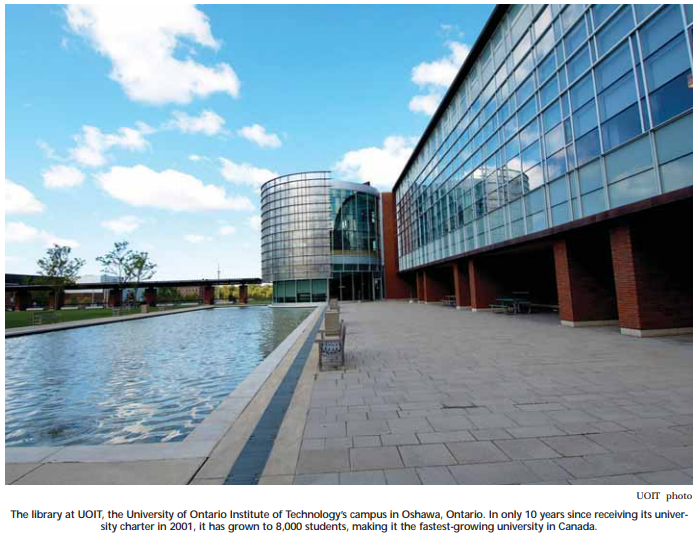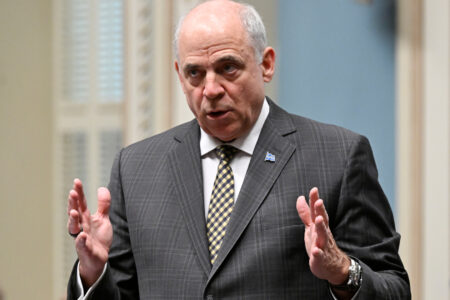
The truth is I didn’t start out to create a so-called “innovative university,” nor a university of any description. Let me take you back to the beginning. On September 23, 1988, I made my debut as president of Durham College in Oshawa, Ontario, having just concluded my rookie presidency at Red River College in Winnipeg. Olympic buffs may recall that was the night Ben Johnson won gold. As a “serendipitist,” I took that as an omen — which I rescinded the next morning. I’ll return to serendipity later.
The record shows I was “a college guy” all my working life — 42 years to be precise. I started at the forerunner institution to Confederation College in Thunder Bay in 1964, shifted to Confederation in 1969 and remained in a college’s employ until I walked out UOIT’s door June 30, 2006, having remained on Durham College’s payroll in the latter years for pension purposes. I was also president of Durham until March 31, 2006, being the only Canadian to serve as president of a college and a university concurrently (2001-06).
So I’ve always loved colleges — their diverse student body, their applied mandate, their market-tested faculty and their close connection to their community (they’re known as “community colleges” for a reason). So when I moved to Oshawa, my intent was purely to be the best college president I could be.
So why UOIT?
Step one of the UOIT journey began several months after I arrived at Durham College when a (male) faculty member dropped in and burst into tears because, as I learned, he and his wife had had to tell their youngest of four children the night before they could not afford to help send her to university. They already had three children in post-secondary education out of town, were both working two jobs, were living in a townhouse to save money — and the cupboard was bare.
The daughter also worked hard but didn’t earn enough to cover tuition, books and out-of-town costs, nor was she eligible for the Ontario Student Assistance Program as her parents (a teacher and a secretary) earned over the limit.
To secure a yes from Premier Harris, the ultimate authority in approving something as huge as a new university, we had to propose something new, something “innovative,” that had nothing to do with geography but everything to do with preserving and growing Ontario’s economic base. And so the phrase “MIT of the North” came to mind.
Coming from northern and western Canada as I did, I couldn’t help reflecting that this would never happen in comparable communities there. After all, Durham Region and Northumberland County (which includes Pickering, Ajax, Whitby, Oshawa, Clarington, Port Hope, Cobourg, Uxbridge and Port Perry) had 400,000 people back then (today, it has over 600,000 and will reach a million within a generation). Compare that to much smaller communities such as Brandon, Regina, Saskatoon, Lethbridge or Prince Rupert — or indeed, to communities in Ontario such as Kingston, Peterborough, North Bay, Thunder Bay, Kitchener, Waterloo or Guelph. Somehow, Oshawa and environs had missed the boat.
Step two is that I got to know the community and noticed it had no daily newspaper, no local TV channel, no performing arts centre, no professional theatre — and no university. By contrast, my hometown of Thunder Bay (and Brandon, etc.) had all of these.
Step three was the emergent role of knowledge as the undeniable passport to an individual’s and community’s success.
So I decided to improve the overall quality of life for my fellow citizens, starting with a university, believing if that happened, other shortfalls (e.g., a performing arts centre) would self-correct. Actually, this isn’t quite true. I didn’t start out to create a university per se but rather to import university programming from Trent, York and Ryerson. This served a purpose for about five years but as the population exploded to the scale of Winnipeg and Hamilton, these arrangements proved inadequate.
The next step, therefore, was to try to create a university. I knew this was virtually impossible, involving many years and abundant rejection, but I had been through that before (as chair of the board that built the Thunder Bay Community Auditorium) so that my patience, persistence and resilience had been hardened.
Task one was to make this a community project, not some individual’s. So, I invited 40 leading citizens from Pickering to Cobourg — leaders from business, education, other professions, labour, politics, religion, multicultural groups, the media — and described the dream, including its inevitably tortuous trajectory. When I then asked if they were in, they all answered yes, knowing that our probability of success was less than 1 percent. This group continued to meet throughout the journey, two to three times per year, and was instrumental with good advice and key advocacy at strategic times.
Task two was to define the “dream.” Because we knew that everyone outside Durham/ Northumberland would hate the whole idea viscerally, we started with the least imposing concept possible — a university that was modest in every way: enrolment, programming, research agenda and so on. I quickly realized it didn’t matter what sort of university we were proposing, as everyone else from afar — educators, civil servants, politicians, media — was fundamentally opposed. No one bought the “geographic fairness” argument (because universities deem themselves universal). Some, those who were closest, feared the new competition. And all worried that the already thin operating and capital pots would be diluted.
Nevertheless, we persevered through various cabinet ministers, deputy ministers, premiers, governments — until the above-mentioned serendipity happened with the election in 1995 of the Progressive Conservative government of Mike Harris, which many will find ironic and/or offensive, given his disdain for much in universities. However, all six MPPs from Durham/Northumberland were Tories, with five of the six in cabinet! — including Janet Ecker and especially Jim Flaherty (without whom there would be no UOIT).
To secure a yes from Premier Harris, the ultimate authority in approving something as huge as a new university, we had to propose something new, something “innovative,” that had nothing to do with geography but everything to do with preserving and growing Ontario’s economic base. And so the phrase “MIT of the North” came to mind — jobs, careers, commercializable research.
So how is UOIT allegedly “innovative”? Let’s start with three words in the name: “Institute of Technology.” In the US and elsewhere, those are prestigious words in a university’s name but not in Canada. So we took a risk, the first of many.
A second risk was to impose a “mandatory laptop” model on our learning philosophy as well as “mandatory learning pedagogy” for all professors. We wanted our students to graduate as genuine technology experts, regardless of their profession, and we wanted our professors to excel as enablers of learning.
A third risk was for UOIT to share a campus with Durham College in truly innovative ways, including shared facilities (e.g., library, student centre, residences, athletic facilities), joint student newspaper, joint student government, and clubs and associations open to both institutions’ students. In fact, since Trent also had students on campus, all of the above was a three-way venture (one year, the student president was actually from Trent University in Peterborough).
A fourth risk was to commit to have the university up and running in two years (instead of the usual five or six).
However, the best way to assess a university’s philosophy is to read its Act and then use it as a benchmark to judge its performance. The
UOIT Act declares a special mission for career-oriented education and seamless credit pathways for college grads. The objects go on to require that the university be innovative, meeting the individual needs of each student and the market needs of employers; be of the highest quality in learning, teaching, research and professional practice; and relate to the Durham/Northumberland region but also Ontario, Canada and the world.
From the Act stemmed the plans, actions, decisions, budgets, processes, programs and projects to make the Act real. Some of these included:
- first, hiring wonderful, proven leaders (e.g., Sheldon Levy, current president of Ryerson, Michael Finlayson, Brian Marshall and Richard Levin) as well as borrowing the expertise from Durham College leaders such as Margaret Greenley and MaryLynn WestMoynes (who went on to become president of Mohawk College);
- second, hiring fine deans who loved the vision and got the job done (e.g., our current dean of engineering, George Bereznai, was the first dean hired, and his background speaks for itself: high school dropout — to become a Hungarian revolutionary — apprentice, journeyman, PEng, MEng, PhD, world expert on nuclear science and distance learning);
- third, building an inspiringly beautiful campus with sculptures and quadrangles of four-storey, green buildings with much natural light;
- fourth, hiring faculty who would be hired by Princeton;
- fifth, launching dozens of programs consistent with our mandate (and inviting Trent to offer general arts on campus, both to its own students and to UOIT’s);
- sixth, building research labs and buildings equal to the best anywhere (e.g., the $123-million Automotive Centre of Excellence);
- seventh, offering only honours undergrad degrees;
- eighth, launching post-grad programs as an urgency (we have already graduated our first PhDs); ninth, guaranteeing every college grad in Canada with a B+ average or higher at least one pathway to year three of an honours degree following a short summer “bridge”;
- ninth, stressing interdisciplinary and leadership courses in every faculty;
- tenth, acquiring 400 acres of E.P. Taylor’s magnificent Windfields Farm; and
- eleventh, beginning to transform Durham/Northumberland (e.g., building/renovating a once-glorious theatre to re-become Oshawa’s “Carnegie Hall,” and building or renovating three other buildings in downtown Oshawa).
So we’ve begun. As to the numbers, many readers will be familiar with UOIT’s Maclean’s and Globe and Mail rankings, with our research per capita results, and with our over 8,000 students this fall, making us the fastest-growing university in Canadian history. But I say this humbly, knowing that it will be at least a quarter century before the jury of public opinion determines whether we will have truly become the “MIT of the North.”
Photo: Shutterstock







